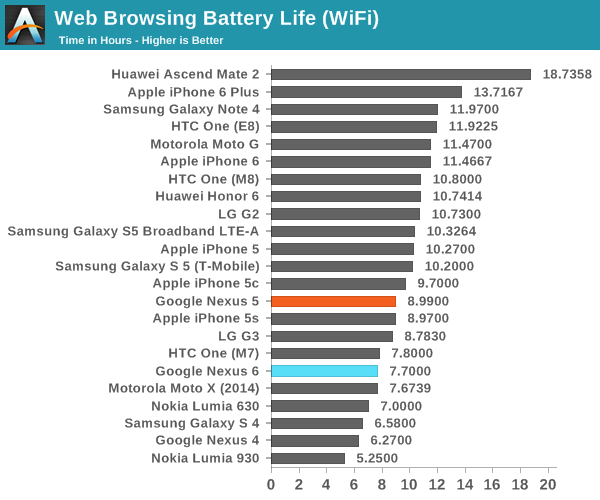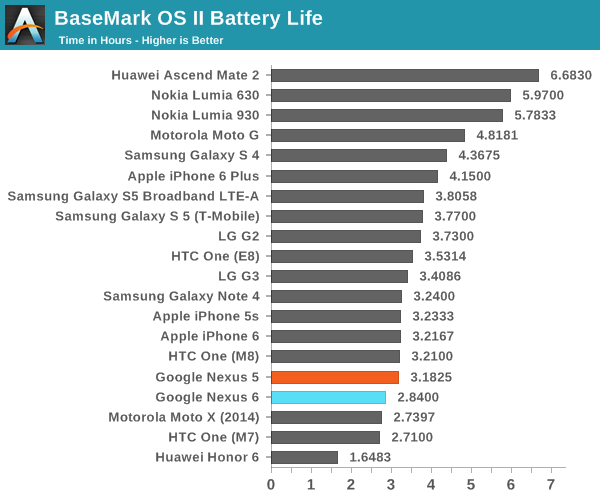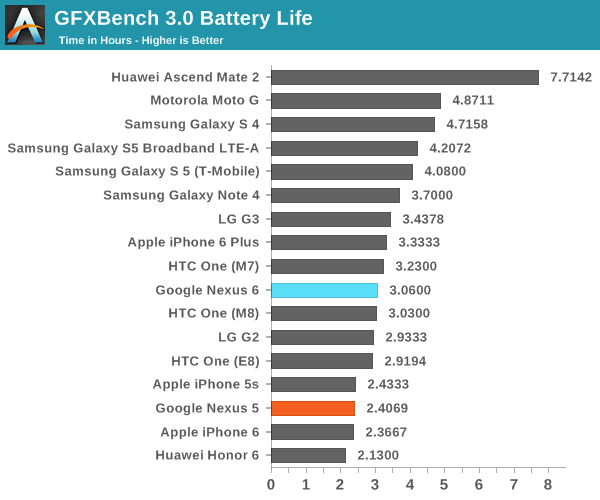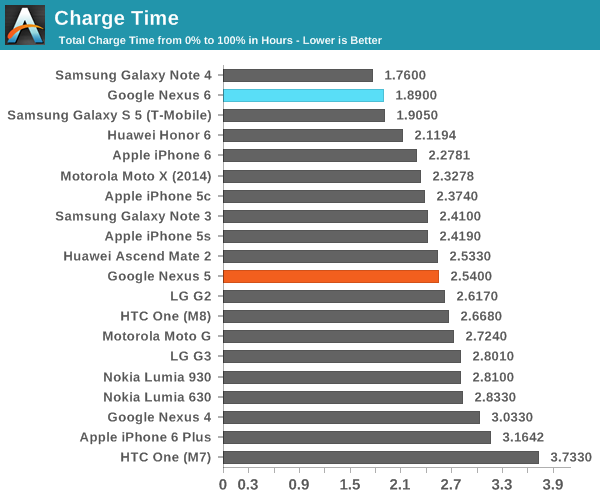The Nexus 6 Review
by Brandon Chester on November 12, 2014 1:00 PM ESTBattery Life
Battery life is one of the most important aspects of a smartphone, as it effectively determines how long you'll be able to use all of its other features. In order to get a comprehensive understanding of battery life on the Nexus 6 we run a variety of tests that attempt to stress different parts of the device in order to determine the battery performance in different conditions. Most important is that all displays are calibrated to 200 nits to avoid penalizing certain phones for having brighter displays than others.

The first test is our WiFi web browsing test which loads a set of web pages in a loop with pauses to avoid penalizing phones with faster SoCs than others. In this test we see that the Nexus 6 does perform somewhat poorly. Compared to Samsung's Galaxy Note 4 which has essentially the same specifications on paper, the Nexus 6 lasts 4.27 hours shorter. It is likely that this can be attributed to the display, which may not be as efficient as the latest and greatest AMOLED panel used in the Note 4.
At this point we would usually post results for web browsing battery life on LTE. However, I've had difficulty locating a place to perform testing with a reliable cellular signal, and I didn't wish to put the Nexus 6 at an unfair disadvantage by performing the test with poor reception. Because of this, I was unable to obtain LTE battery life results for the Nexus 6, but given the platform it's likely that battery life is around 7.25 to 7.5 hours on our LTE web test.


In our more SoC-bound BaseMark OS II battery test we see that the Nexus 6 doesn't last quite as long as the Note 4. This is again likely due to a higher display power consumption on the Nexus 6, as both devices share the same SoC fabricated on the same process. However, we see that the battery score is a bit higher, likely due to a higher average CPU frequency afforded by a larger heat dissipation area to reduce throttling.


With GFXBench which is a more GPU focused test, we see similar results to our BaseMark OS II test. The Nexus 6 doesn't last quite as long as the Galaxy Note 4, with slightly more than 3 hours of usage compared to the Note 4 with 3.7 hours of usage. The gap definitely closes between the two here, but unfortunately it seems that the display continues to hurt overall battery life. The fact that the web browsing result is so close here suggests that Motorola is continuing to target "24 hours of mixed usage", so if one does fit their usage model they shouldn't have isssues lasting a day on battery. I can't help but think that a good LCD would get them much more battery life for the same battery size, but it should be usable here even if it's behind the competition.
Charge Time
The charge time of a smartphone is also very important. While having a long battery life means that a device can be used for longer, if it also requires a very long charging time it may be that the device is less frequently able to be fully charged and thus unable to actually reach its potential battery life. Charge time can also be an important factor in time-constrained situations such as topping up your battery before a flight. In order to test battery life we deplete the device's battery charge to 0, and then measure the duration that the device is plugged in until it reaches a power draw that indicates it is completely charged.

The Nexus 6 includes Motorola's Turbo Charger which can output 9V at 1.6A or 12V at 1.2A to Qualcomm Quick Charge 2.0 compatible devices. As you can see above, this leads to an exceptionally low charge time of 1.89 hours. I'm very glad that Google and Motorola decided to include the Turbo Charger instead of a typical 5W adapter. Something I would like to note is that my Turbo Charger did exhibit very noticeable coil whine, although this may have simply been an issue specific to my unit.










136 Comments
View All Comments
Brett Howse - Friday, November 14, 2014 - link
It's removed and I was "that reviewer".Apparently wifi scores are the single most critical piece of any smartphone review so this won't happen again.
jaysns - Thursday, November 13, 2014 - link
If you do the storage performance tests with the encryption enabled and disabled on the Nexus 5 you see a huge difference. As the 6 comes with this on by default and does not have a way to manually disable this (as far as I know) I'd love to see a follow up article by Anandtech on this issue and see if they can reproduce this and possibly find a way to disable it on the Nexus 6 and compare results. Based on what I've seen, if I can't disable it, or their storage is really just that slow, it would make a difference on my purchasing decision and possibly help other in the same boat. So please do a follow if you can :)Vizsla1986 - Thursday, November 13, 2014 - link
This particular review is an outlier against all the others, which are basically raves. Some of that is explicable - a lot of sites do pro forma reviews colored by a priori bias - but not all.Since I'm someone who purchased the original Moto X (loved it), upgraded to the Droid Turbo a couple of weeks ago (hated it. Returned it immediately) and then bought a 2nd Gen Moto X, a couple of comments based on actual experience.
1) Everyone needs to look at specs with a jaundiced eye. Sometimes they matter (storage) and sometimes it's contextual (RAM, for example. Depends on how system is used) but most of the time it's about throughput.
2) The Moto X was at least as fast, if not faster on throughput then every phone I compared it to, despite worse specs. A lot of that was display. 720 p is a lot easier on a system than 1080, but also not nearly as good. The 2nd gen. Moto X is *faster* in everyway, IMHO, than the Droid Turbo. I'd say that's also display-related, but the difference here is that the Turbo's screen (same as the Nexus 6) wasn't any better to my eyes than the Moto X 1080. YMMV, but one should carefully check this out. If you can't tell the difference (or much of one) consider the system impact.
2) The Moto X is clearly as fast (actually seems faster) as the Turbo despite an 801 chip compatred to the 805, and different clock speeds. Since I haven't had a chance to handle the Nexus 6, I can't compare, but I would urge anyone considering to pick the the two phones and compare throughput.
3) Clearly the Phablet Nexus 6 is a different experience than a smaller phone. I'm struck, though, that every single review I've read (maybe 6 of them now) has screamed themselves hoarse about how good the Nexus screen is. It's ok to be different, but *that* different? I'd recheck my report if I were the only person criticizing what everyone else thought the best thing about the phone. That's not different. That's idiosyncratic. On a phone this big, display quality is a simple thing to judge. There may be subtleties presenting on measurement, but one should be able at a glance to judge good or bad. I find this review suspect on that ground, never mind the measurements. FWIW, the DROID TURBO was bright enough. So is the Moto X. Why should the Nexus 6 be so different?
4) The price seems eminently reasonable, considering dimensions and specs. I understand why people want to see a cheaper Nexus alternative, but pricing needs to compared against delivered value, not just what one wished for.
5) Battery life. FWIW, I have never, ever, ever never needed to recharge any of the three Motorola phones I've had recently (Moto X Nos. 1 & 2 and the Droid Turbo)before going to bed. Once in a while I've drained to to a 10% remaining, but that would be it. The Turbo had an immense batterry (3900), so that's one explnation, but the 2nd Gen Motox X has only 2400 (from memory. Might be 2200). No problem. Motorola engineers are good at designing systems that get through the day on a charge. The Nexus has what? 3200? That ought to be good enough.
To be fair, everything depends on usage, and I'm not the hardest guy on batteries out there. I watch very little media (so no display drain), mostly calls, text and browsing. Someone else might have a much worse time of it. All I can attest to is my Moto phones have been spectacularly good (for me, anyway).
When I make a major purchase, I always check various vendors and compare thoroughly. If this review were in a purchase matrix I was running, I'd throw it out. It's always been a good policy for me to disregard the high and low bidders (or reviews) unless there was an exceptional circumstance. I don't see one here. I don't trust this review. I can't remember ever saying that about any other AnandTech report.
Graag - Sunday, November 16, 2014 - link
>This particular review is an outlier against all the others, which are basically raves. Some of that is explicable - a lot of sites do pro forma reviews colored by a priori bias - but not all.This is not true at all. Both the arstechnica and Verge reviews also found the Nexus 6 to be "meh".
randomlinh - Friday, November 28, 2014 - link
I dunno, most of the reviews seemed like a mixed bag to me, though leaning positive. But on the screen... AT is one of the only site to give tested numbers. Everyone has been a subjective "it looks great, just a little dim, but probably bright enough". That's not entirely helpful.The Note 4 gets a huge nod from displaymate which seems to mirror the results here: http://www.displaymate.com/Color_Accuracy_ShootOut...
gg555 - Thursday, November 13, 2014 - link
Sigh. No review of the noise cancellation. No mention of whether or not it has the four microphone noise cancellation found in the Moto X. No mention of whether it uses Motorola's CrystalTalk, Qualcomm's Fluence, Audience, or some other noise cancellation.My favorite part of the AnandTech cell phone reviews has totally died. And they were the only one doing it. What a shame.
davidc1 - Saturday, November 15, 2014 - link
Yes, yes, yes! Why no mention of audio quality, call quality, noise cancellation, etc, etc. Very disappointed.lanwellon - Thursday, November 13, 2014 - link
Hi, Brandon, I think you should point out that the reason why the Nexus 6 use the battery so quick is not all because of the bigger screen and more powerful CPU, please be noticed that in all the mobile phones you tested in this table, Nexus 6 is the only one running Android L, and Google enabled FDE (Full-Disk Encryption) function by default from Android 5.0. From my experience using Android 4.0 (Ice Cream Sandwich) FDE function, this can be a reason that cause the battery running down very fast. iPhone also enable FDE function by default, but it seems that Apple optimized it pretty well, so the impact to the battery usage is not that big.ol1bit - Friday, November 14, 2014 - link
There is always a segment of the population that buys Nexus devices because they are factory boxes. This is too make sure people who want a Samsung, HTC, etc. phone are not swayed by the low price to a Nexus device. Goggle doesn't want manufactures to die off, the price of a phone is not how they make their money.murphsp1 - Friday, November 14, 2014 - link
I have owned several Nexus devices and must say that the battery life numbers on this one look terribly disappointing ... and will only get worse over time. I just hope that more manufacturers start to understand that many would happily trade off an extra mm or two in thickness for an extra day of battery life. Now, fingers crossed that the Google Play edition of the Droid Turbo is coming ...